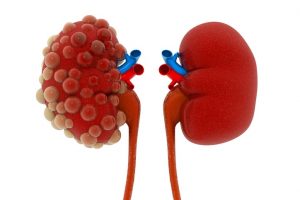 Deep-vein thrombosis (DVT) is the formation of a blood clot in a blood vessel deep within the body. If the clot breaks free and travels into the lungs, it causes a pulmonary embolism, which can result in shortness of breath, chest pain when breathing, and coughing up blood. Deep-vein thrombosis has previously been associated with chronic kidney disease (CKD), in that CKD increases the risk for patients to develop deep-vein thrombosis.
Deep-vein thrombosis (DVT) is the formation of a blood clot in a blood vessel deep within the body. If the clot breaks free and travels into the lungs, it causes a pulmonary embolism, which can result in shortness of breath, chest pain when breathing, and coughing up blood. Deep-vein thrombosis has previously been associated with chronic kidney disease (CKD), in that CKD increases the risk for patients to develop deep-vein thrombosis.
Currently, information on the incidence of deep-vein thrombosis in patients with the later stages of chronic kidney disease, called end-stage renal disease (ESRD), is lacking. For this reason, a group of researchers set out to answer some questions about the effects of end-stage renal disease on deep-vein thrombosis. The researchers examined the incidence of deep-vein thrombosis in Asian end-stage renal disease patients compared to non-ESRD patients to identify whether ESRD increased the risk of deep-vein thrombosis in patients.
Advertisement
The researchers gathered medical data on 3,564 end-stage renal disease patients between 2004 and 2010, from the National Health Insurance Research Database in Taiwan. Patients were excluded from the study if they had previously been diagnosed with deep-vein thrombosis or if they did not have complete medical records based on the researchers’ criteria. The control group was made up of 5,094 non-ESRD patients, matched to the experimental group based on age (within six years), gender, and the year of admission into the study.
Hypertension and Diabetes Risk Factors for Deep-Vein Thrombosis
On average, participants were around the age of 62, with an almost equal division of men and women. The incidence of deep-vein thrombosis in patients with end-stage renal disease was nearly 20 times that of the patients without end-stage renal disease, relating to a higher risk of developing deep-vein thrombosis with end-stage renal disease than without.
They also found that the incidence of deep-vein thrombosis increased with age in the patients with end-stage renal disease. Patients with end-stage renal disease showed a higher likelihood of being diagnosed with several comorbidities that are risk factors for deep-vein thrombosis, including hypertension and diabetes, and those with three or more risk factors for deep-vein thrombosis had an even higher risk of developing it.
The current study raises additional questions about the source of the increase in the risk of deep-vein thrombosis related to end-stage renal disease in Asian populations. Previous studies have found a two-fold increase in the risk of deep-vein thrombosis in American populations of patients with end-stage renal disease.
Advertisement
In the past, studies have noted that Asian populations have a lower overall incidence of deep-vein thrombosis and pulmonary embolism than other international populations (which was affirmed by the results in this study), so the finding that end-stage renal disease increases risk of deep-vein thrombosis by around 20 times is particularly confounding.
Overall, additional studies will be needed to expand the findings to an international population, as well as to understand how demographics play a role in the development and risk factors of deep-vein thrombosis in end-stage renal disease patients.
Also read: Renal colic: Symptoms, causes, and prevention tips
